Table of Contents
ToggleThe IT Infrastructure Library (ITIL) has long been the cornerstone of IT service management (ITSM) practices, guiding organizations in delivering value through effective service management. With the release of ITIL 4, the framework has undergone significant updates to remain relevant in today’s rapidly evolving digital landscape. ITIL 4 represents a major shift from its predecessor, ITIL V3, embracing new methodologies like Agile, DevOps, and Lean, and focusing on value co-creation, flexibility, and customer-centricity. This article delves into the major changes and updates in ITIL V4, exploring what makes ITIL 4 unique, how it differs from ITIL V3, and what it means for organizations and IT professionals alike.
What is ITIL 4?
ITIL 4 is the latest evolution of the IT Infrastructure Library, a globally recognized framework for IT service management. It provides a flexible, scalable approach to managing IT services, helping organizations navigate the complexities of digital transformation. ITIL 4 expands on the foundation laid by previous versions, offering a more holistic and integrated view of service management that aligns with modern business practices.
Strategic Importance
In an era where digital services are central to business success, ITIL 4 plays a crucial role in helping organizations deliver consistent, high-quality services. By focusing on value creation and customer outcomes, ITIL 4 ensures that IT services are not only aligned with business objectives but also continuously improved to meet changing needs.
What is New in ITIL 4?
The transition from ITIL V3 to ITIL 4 introduces several key innovations that reflect the evolving landscape of IT and service management. ITIL 4 moves away from the linear processes of previous versions and adopts a more dynamic, flexible approach that can adapt to the fast-paced nature of today’s business environment.
Key Innovations
One of the most significant changes in ITIL 4 is the introduction of the Service Value System (SVS), which provides a comprehensive framework for creating, delivering, and continually improving services. The SVS includes components like the Service Value Chain, guiding principles, governance, and continual improvement, all of which work together to ensure that organizations can respond effectively to changes and deliver maximum value to customers.
Alignment with Agile, DevOps, and Lean
Another major innovation in ITIL 4 is its integration with other modern methodologies such as Agile, DevOps, and Lean. This alignment allows organizations to leverage the strengths of these approaches while maintaining the structure and discipline of ITIL, creating a more agile and responsive ITSM environment.
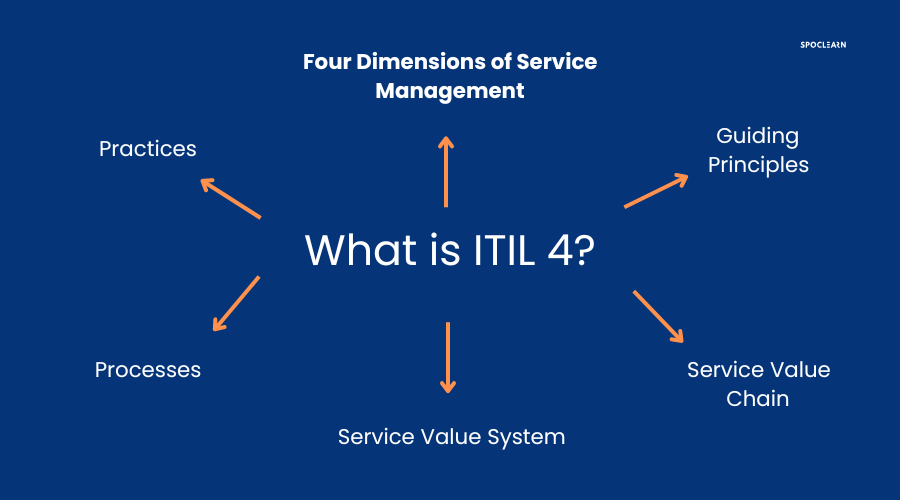
Why ITIL 4 is Unique?
ITIL 4 stands out from its predecessors and other ITSM frameworks due to its holistic, flexible approach to service management. It is designed to be adaptable to the unique needs of each organization, regardless of size, industry, or maturity level.
Holistic Approach
Unlike previous versions, which focused primarily on processes, ITIL 4 emphasizes a comprehensive approach that considers all aspects of service management, including people, technology, partners, and processes. This holistic view ensures that all elements work together seamlessly to deliver value.
Flexibility and Scalability
ITIL 4 is highly adaptable, making it suitable for organizations of all sizes and industries. Whether you’re a small startup or a large enterprise, ITIL 4 provides the tools and guidance you need to scale your service management practices effectively.
Customer-Centric Focus
One of the key tenets of ITIL 4 is its focus on the customer. The framework emphasizes the importance of understanding and delivering on customer needs, ensuring that services are designed and managed with the end-user in mind.
ITIL 4 Framework: Changes and Updates
The ITIL 4 framework introduces several changes and updates that reflect the shift towards more agile and responsive service management practices.
From Processes to Practices
One of the most significant changes in ITIL 4 is the shift from processes to practices. While ITIL V3 was built around a set of rigid processes, ITIL 4 introduces flexible practices that can be adapted to suit the specific needs of an organization. This change allows organizations to be more responsive to changes in the business environment and better equipped to deliver value.
Service Value Chain
At the heart of ITIL 4’s Service Value System is the Service Value Chain, a key component that outlines the activities required to create value. The Service Value Chain is flexible, allowing organizations to customize their approach to service delivery based on their unique needs and goals.
Continual Improvement Model
ITIL 4 places a greater emphasis on continual improvement, recognizing that service management is an ongoing process that requires constant evaluation and enhancement. The Continual Improvement Model provides a structured approach to identifying and implementing improvements, ensuring that services continue to meet evolving business needs.
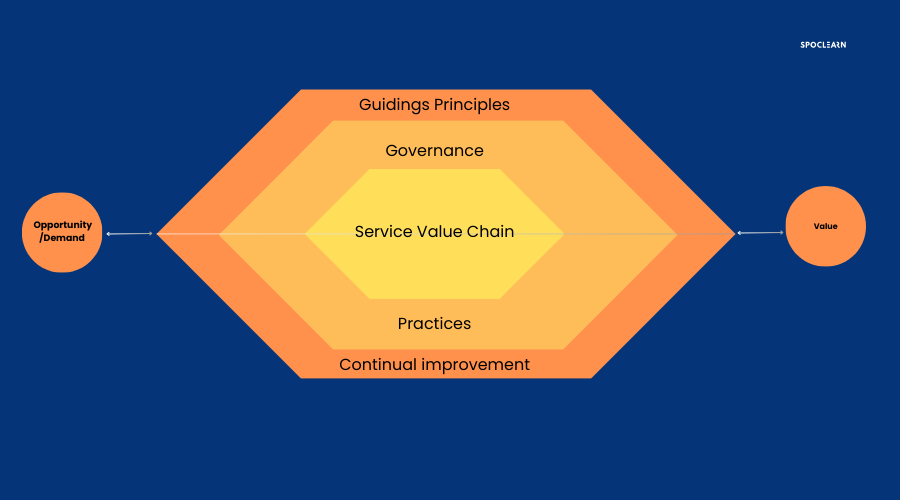
How ITIL 4 Is Different from ITIL V3
ITIL 4 represents a significant departure from ITIL V3, both in terms of structure and focus.
Structural Differences
ITIL V3 was built around a service lifecycle, with distinct stages such as service strategy, service design, service transition, service operation, and continual service improvement. In contrast, ITIL 4 introduces a more flexible, value-oriented model that emphasizes the end-to-end management of services, from conception to delivery and beyond.
Expanded Focus Areas
While ITIL V3 focused primarily on processes, ITIL 4 expanded its focus to include practices that encompass all aspects of service management. This includes areas like governance, risk management, and compliance, which are critical to ensuring that services are not only effective but also aligned with business objectives and regulatory requirements.
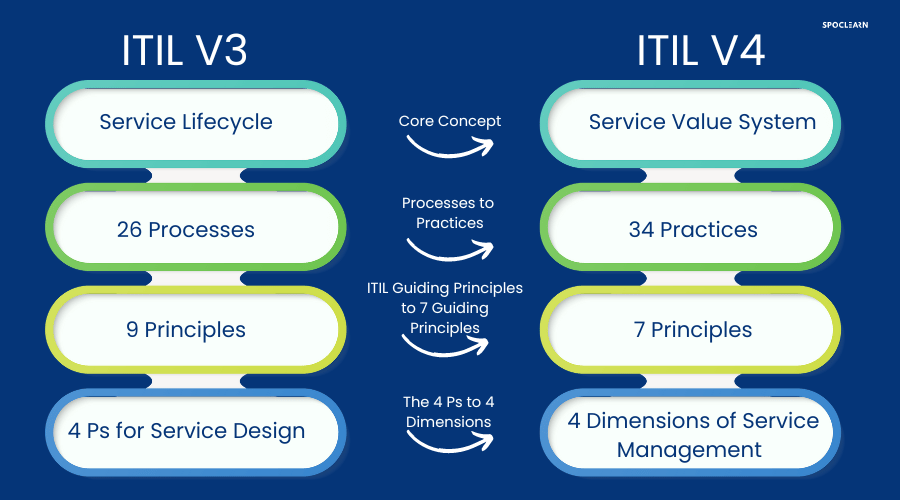
Evolving Roles and Responsibilities
As part of its focus on flexibility and adaptability, ITIL 4 redefines roles and responsibilities within the IT organization. This shift reflects the changing nature of IT service management, where cross-functional teams and collaborative practices are becoming increasingly important.
Service Value System (SVS)
The Service Value System (SVS) is one of the most important innovations in ITIL 4, providing a holistic framework for creating, delivering, and improving services.
Core Components of SVS
The SVS is made up of several key components, including the Service Value Chain, guiding principles, governance, continual improvement, and practices. Together, these elements ensure that services are delivered in a way that aligns with organizational goals and meets customer needs.
Integration with Business Strategy
One of the key strengths of the SVS is its ability to integrate with business strategy. By aligning IT services with organizational objectives, the SVS ensures that ITSM practices contribute directly to business success.
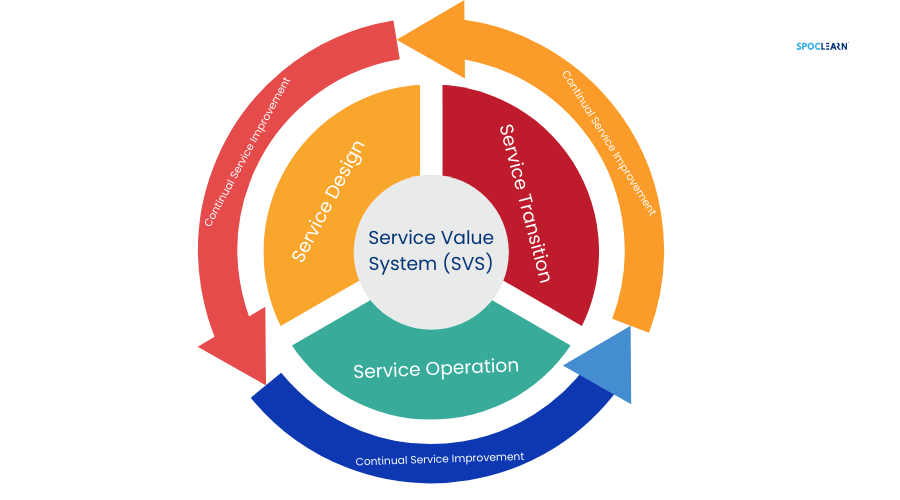
Guiding Principles of ITIL 4
The guiding principles of ITIL 4 are fundamental to its approach, providing a set of core values that inform decision-making and drive continuous improvement.
Overview of the Guiding Principles
ITIL 4 introduces seven guiding principles that reflect the core values of the framework: focus on value, start where you are, progress iteratively with feedback, collaborate and promote visibility, think and work holistically, keep it simple and practical, and optimize and automate.
Application in Real-World Scenarios
These principles are not just theoretical concepts but practical tools that can be applied in real-world scenarios. For example, the principle of “focus on value” ensures that all activities and initiatives are aligned with customer needs and organizational goals, while “progress iteratively with feedback” encourages continuous improvement through small, manageable steps.
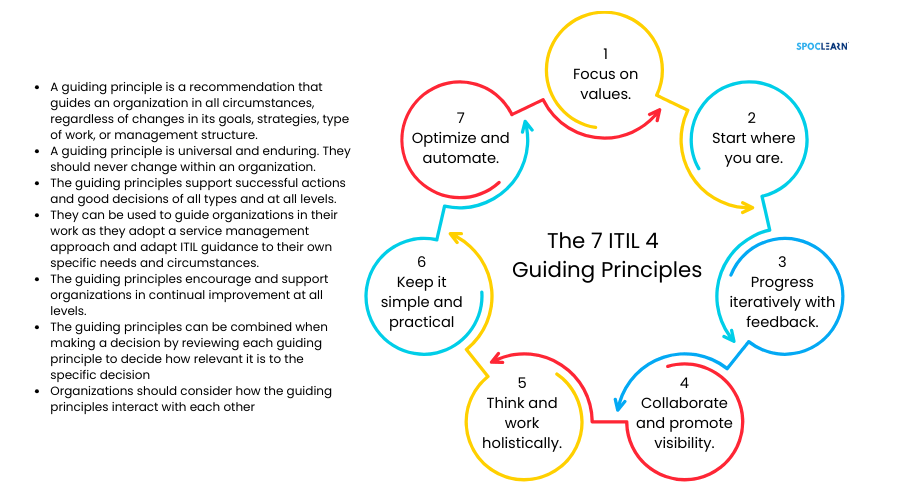
The Importance of the Service Value System
The Service Value System (SVS) is central to ITIL 4, providing a comprehensive framework for managing and improving services.
Value Co-Creation
One of the key concepts of the SVS is value co-creation, which emphasizes the importance of collaboration between service providers and customers. By working together, both parties can ensure that services are designed and delivered in a way that meets their needs and expectations.
Cross-Functional Collaboration
The SVS also encourages cross-functional collaboration, recognizing that effective service management requires input and cooperation from all parts of the organization. This collaborative approach ensures that services are delivered in a way that is aligned with organizational goals and meets customer needs.
What Does ITIL 4 Mean for You and Your Organization?
Adopting ITIL 4 can have significant benefits for organizations, helping them to improve their service management practices and deliver greater value to customers.
Benefits of Adopting ITIL 4
Some of the key benefits of ITIL 4 include improved flexibility, greater alignment with business objectives, enhanced customer focus, and a stronger emphasis on continual improvement. By adopting ITIL 4, organizations can ensure that their ITSM practices are aligned with the latest best practices and are capable of meeting the demands of today’s digital environment.
Challenges to Consider
While the benefits of ITIL 4 are clear, there are also challenges to consider when adopting the new framework. These may include the need for training and certification, the complexity of transitioning from ITIL V3 to ITIL 4, and the need to align existing practices with the new framework.
What Do the New ITIL 4 Qualifications Look Like?
The introduction of ITIL 4 has also brought changes to the ITIL certification scheme, with new qualifications and pathways for IT professionals.
Certification Pathways
The ITIL 4 certification scheme includes a range of qualifications, from the Foundation level to more advanced certifications like Managing Professional and Strategic Leader. These qualifications are designed to provide IT professionals with the knowledge and skills they need to implement ITIL 4 in their organizations.
Relevance to Career Growth
For IT professionals, obtaining ITIL 4 certifications can be a significant boost to their careers, providing them with the skills and credentials needed to advance in the field of IT service management.
How Will the ITIL 4 Update Affect Existing ITIL Qualification Holders?
For those who hold existing ITIL V3 qualifications, the transition to ITIL 4 may require some additional training and certification.
Transition Pathways
There are several pathways available for ITIL V3 certification holders to transition to ITIL 4, including the ITIL 4 Managing Professional Transition module, which allows individuals to bridge the gap between the two versions.
Continuing Professional Development
As with any professional certification, it’s important for ITIL V3 qualification holders to stay updated with the latest best practices and frameworks. Continuing professional development is essential for ensuring that IT professionals remain competitive in the job market.
How Will ITIL 4 Affect the Pink Elephant PinkVERIFY ITSM Tool Certification Scheme?
The Pink Elephant PinkVERIFY ITSM tool certification scheme is a well-known benchmark for ITSM tools, and the introduction of ITIL 4 has had an impact on this certification.
Impact on Tool Certification
With the changes introduced in ITIL 4, ITSM tools will need to adapt to meet the new requirements. This may involve updates to existing tools or the development of new features that align with ITIL 4’s practices and Service Value System.
Alignment with Modern Tools
ITIL 4’s emphasis on flexibility, integration, and customer focus means that ITSM tools will need to be more adaptable and responsive than ever before. As a result, we can expect to see continued innovation in the ITSM tool market as vendors work to align their products with the new framework.
The Impact ITIL 4 Will Have on ITSM Tools
The introduction of ITIL 4 will have a significant impact on the ITSM tool landscape, driving innovation and encouraging the development of more advanced, flexible tools.
Tool Adaptation
As organizations adopt ITIL 4, ITSM tools will need to adapt to support the new framework. This may involve updates to existing tools or the development of new features that align with ITIL 4’s practices and Service Value System.
Enhanced Capabilities
With the introduction of ITIL 4, we can expect to see ITSM tools offering enhanced capabilities that support the framework’s focus on value creation, flexibility, and continual improvement.
How To Get Started with ITIL 4
For organizations looking to adopt ITIL 4, there are several steps that can help ensure a smooth transition.
Implementation Roadmap
The first step in adopting ITIL 4 is to develop an implementation roadmap that outlines the key steps and milestones for the transition. This roadmap should include a thorough assessment of existing practices, identification of gaps and areas for improvement, and a plan for training and certification.
Resources and Training
To support the transition to ITIL 4, organizations should invest in resources and training programs that provide employees with the knowledge and skills they need to implement the new framework. This may include attending ITIL 4 training courses, obtaining certifications, and accessing online resources and tools.
Conclusion
The release of ITIL 4 marks a significant milestone in the evolution of IT service management. With its focus on value creation, flexibility, and integration with modern methodologies, ITIL 4 provides organizations with the tools they need to thrive in today’s digital landscape. By adopting ITIL 4, organizations can ensure that their ITSM practices are aligned with the latest best practices and are capable of delivering maximum value to customers. As the ITSM landscape continues to evolve, ITIL 4 will play a crucial role in shaping the future of service management, helping organizations navigate the challenges of the digital age and achieve their business objectives.
